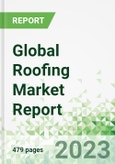This report includes demand data (2012, 2017, and 2022), forecasts (2027 and 2032), and annual historical and forecast data from 2019 to 2026 by market and application.
Global demand for roofing products is forecast to increase 2.1% per year to 15.6 billion square meters in 2027, driven by:
- significant growth in building construction activity in the Asia/Pacific and Africa/Mideast regions
- homeowners and building owners preemptively replacing their roofs with more environmentally friendly products and cool roofing in order to reduce energy use or meet regulations, which will result in increased use of solar, green, and single-ply roofing products
However, market value growth will see a sharp deceleration from a high 2022 base that resulted from inflationary pressures and pandemic-related supply chain issues. Going forward, roofing prices will experience a major correction in 2023 and moderate through 2027 with the prices of several roofing materials seeing aggregate declines in prices.
This report covers roofing demand by region, country, market and application, and product, as well as roofing production. Demand data are presented in both square meters and US dollars, while production estimates are presented in US dollar terms.
The markets broken out are:
- New residential
- Residential reroofing
- New nonresidential
- Nonresidential reroofing
The major products analyzed are:
- Tile
- Bituminous
- Asphalt Shingles
- Metal
- Plastic Single-Ply
- Rubber Single-Ply
- Fiber Cement
- Other (e.g., bamboo, thatch, wood, solar, green roofs)
Scope of the Report
This industry study analyzes the $130 billion global roofing industry. It presents historical demand data (2012, 2017, and 2022), forecasts (2027 and 2032), and annual historical and forecast data from 2019 to 2026 by market and application (new residential, residential reroofing, new nonresidential, and nonresidential reroofing) and product (tile, bituminous, asphalt shingles, metal, plastic single-ply, rubber single-ply, fiber cement, and small volume roofing products). The study discusses the impact of the COVID-19 pandemic. The study also evaluates company market share and competitive analysis on such industry players as including Beijing Oriental Yuhong Waterproof Technology, Berkshire Hathaway (Johns Manville), BlueScope Steel, Carlisle, Etex, Holcim Group, IKO Group, Owens Corning, Saint-Gobain, Siam Cement, Sika, Standard Industries (Braas Monier, Icopal, GAF Materials), and Wienerberger Baustoffindustrie.
Single-Ply Roofing Products to Gain Market Share
Both plastic and rubber single-ply roofing products are expected to gain share in the global roofing market through 2027, mostly at the expense of bituminous membranes. The favorable performance properties of most single-ply products relative to bituminous roofing will be the primary drivers of this trend. Demand for plastic single-ply roofing membranes will be promoted by:
- rising use of self-adhesive single-ply membranes because of their ease of installation - an important consideration for time-pressed contractors often dealing with less experienced crews
- their ability to be used as cool roofing
- manufacturer efforts to offer products with thicker scrims that impart enhanced resistance to impacts and tears
Solar & Green Roofing Products to Post Robust Gains
Although they will continue to account for a small share of global roofing, demand for solar and green roofing products will rise at a rapid rate, supported by an ongoing shift to more energy-efficient roofing products in both residential and nonresidential structures throughout the world:
- Demand for solar roofing is expected to increase greatly through 2027, fueled by efforts in the US and Western Europe to improve energy efficiency and combat climate change. For instance, California has instituted building codes that encourage, or in some cases require, the installation of solar power on buildings. Sales will also be boosted by falling prices for solar roofing, making this product increasingly attractive to homeowners and building owners looking to reduce their utility bills and carbon footprint.
- Green roofing will also experience sizable growth through 2027, bolstered by their increasing use in a number of high-income countries and building code requirements in some countries (e.g., Canada and China) that mandate their use on certain types of buildings.
Table of Contents
Companies Mentioned
- Beijing Oriental Yuhong Waterproof Technology
- Berkshire Hathaway (Johns Manville)
- BlueScope Steel
- Carlisle
- Etex
- Holcim Group
- IKO Group
- Owens Corning
- Saint-Gobain
- Siam Cement
- Sika
- Standard Industries (Braas Monier, Icopal, GAF Materials)
- Wienerberger Baustoffindustrie








